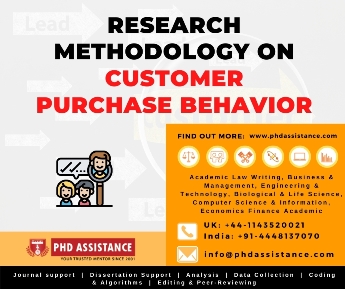Research Methodology on Customer purchase Behavior
Introduction:
Consumer behavior has the triggered the attention of social science researchers for the past 50 years since it includes the study of how individuals obtain, use, read, dump, and make decisions in the products and services, and even lifestyle behaviors of individuals or groups such as socially conscious and healthy eating etc.

Consumer behavior literatures is comprehensive, as developments in culture, economics, and technologies influence the behavior of the individuals (Peighambari et al., 2016). It allows us to better consider and forecast consumer purchasing behavior in the marketplace. However, consumer behavior research is not only about what consumer purchasing behavior but also it is related to why they buy it, where they buy it, and how and how much they buy it. Furthermore, it is also focused on how people use and dispose a product, it occurs at all stages of the purchasing process: before, after, and during the purchase. Each project involving customer behavior analysis can have its own set of problems and approaches. Still, researchers must follow the same basic steps in the design of any study project which is shown in the below figure (Chrysochou, 2017).

Figure 1: Steps in the design of research
In the field of consumer behavior, there are various types of data collection techniques used to analyze the different aspects of customer behavior. Researchers must review data in order to study some phenomena in the area of customer behavior. Data can be primary or secondary, depending upon the source (Chrysochou, 2017). Primary research entails using research techniques such as focus groups, surveys, interviews etc. that are expressly designed to address the study’s objectives whereas secondary research relies on publicly accessible sources and records.
The choice of a primary research is largely determined by whether the study aims to enumerate actions or investigate viewpoints which include attitudes, beliefs and perceptions of individuals. Methods such as ethnography, focus groups and in-depth interviewing may be used if the research targets to investigate viewpoints to gain a deep understanding of the phenomena. On the other hand, if the aim of the research is to get a broad description of the phenomena rather than to dig deeper into it, survey methodology should be used.
Focus Group
A focus group is a type of debate where group of people put their opinion forward within their subject of interest to the researcher and it is one of the popular methods of a qualitative study. A focus group is typically adopted to investigate customer perceptions of emerging product trends which includes product ranges, packaging types, new brands etc.. Further, Participants’ expectations, emotions, opinions, and ideas about a brand, product, or service will be debated to explore methods thereby increasing consumer acceptance.
In-depth interviews
An in-depth interview entails performing extensive individual interviews within a limited number of respondents in order to investigate their viewpoints within the study context and it also a popular technique in qualitative method. In-depth interviews will be suitable if the author wishes to achieve a more in-depth understanding of the respondents’ perspectives on the subject under review.
Ethnography
Ethnographic investigation is conducted in the natural world in order to observe how people act. Language usage, customs, ceremonies, interactions, and artefacts are all detailed descriptions provided by an ethnographer. While participant findings and ethnography are indistinguishable for some researchers, ethnography has a second sense in that it refers to both a form of study.
Survey
Survey technique is one of the popular techniques in quantitative method. This technique generally aims to investigate the features of a target group, understanding their behaviors, expectations, motivations, values, and, in general, gathering their views and it also associates sample, developing questionnaire, and collecting data.
The above explained techniques have its own strong point and weaknesses, and thus scholars should be mindful of before deciding on one. Consumer behavior research is concerned with real and social occurrences that are dynamic and difficult to understand or interpret. Thus, methods in consumer behavior analysis will not often seek to make precise predictions of such phenomena, rather it seeks to clarify and provide rationale for such phenomena.
References
Chrysochou, P. (2017). Consumer Behavior Research Methods. In Consumer Perception of Product Risks and Benefits (pp. 409–428). Springer International Publishing. https://doi.org/10.1007/978-3-319-50530-5_22
Peighambari, K., Sattari, S., Kordestani, A., & Oghazi, P. (2016). Consumer Behavior Research. SAGE Open, 6(2), 215824401664563. https://doi.org/10.1177/2158244016645638



